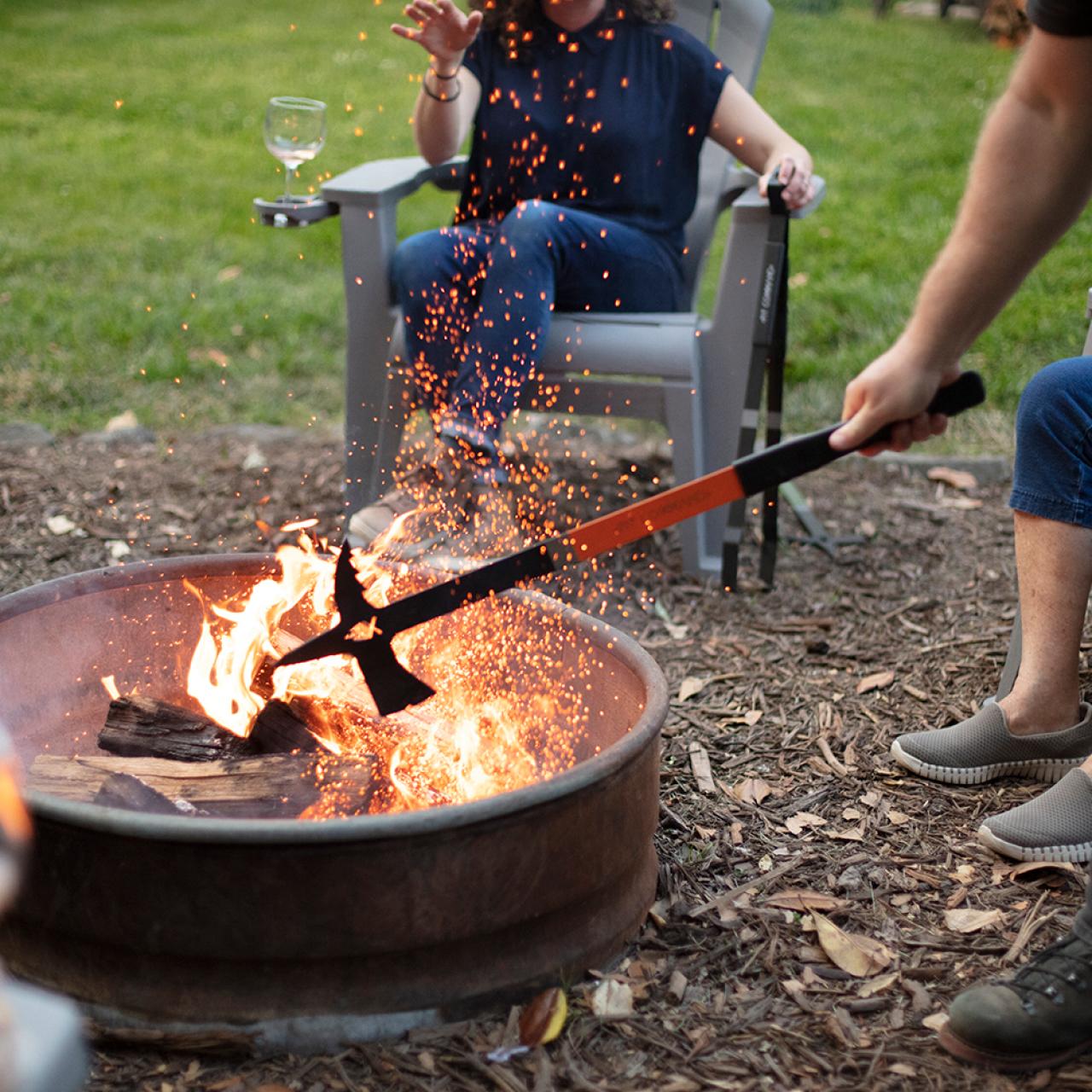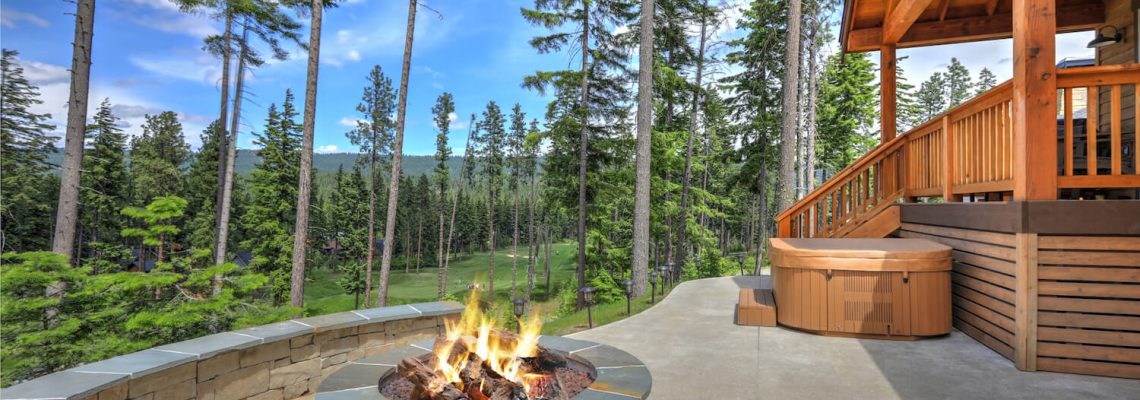To protect grass when using a fire pit, place a fire-resistant mat underneath to prevent heat damage and protect the roots. When enjoying a fire pit on your grassy lawn, it’s essential to take precautions to ensure the safety of your outdoor space.
One crucial aspect to consider is what to place under the fire pit to shield the grass from potential heat damage. By using a fire-resistant mat as a protective barrier, you can prevent the heat from harming the grass and keep your outdoor area looking pristine.
In this guide, we’ll explore the importance of using a fire pit mat on grass and provide helpful tips for ensuring a safe and enjoyable fire pit experience in your backyard.

Preparing The Fire Pit Area
To prepare the fire pit area on grass, it’s essential to use fire-resistant materials such as a fire pit mat to prevent heat damage to the grass. Additionally, misting the surrounding grass with water before lighting the fire can help prevent heat stress and contain any potential sparks.
Choosing The Right Location
- Find a level area away from overhanging trees or structures.
- Ensure there are no underground utility lines in the vicinity.
Using A Protective Base Mat
Place a fire pit mat or heat-resistant pad under your fire pit to protect the grass.
Avoid constant heat stress and dead spots by relocating the fire pit.
Protecting The Grass
Protecting your grass from a fire pit’s heat is crucial to maintaining a healthy lawn.
Misting The Surrounding Grass
Mist the grass near the fire pit with water before lighting it to prevent heat stress.
Using A Fire Pit Screen
Utilize a fire pit screen to contain any sparks and embers that may pose a fire risk to your grass.
Preventing Heat Damage
To prevent heat damage when placing a fire pit on grass, using a fire pit mat is crucial. It acts as a barrier, safeguarding the grass from potential damage caused by the heat. Additionally, misting the surrounding grass with water before lighting can help mitigate heat stress.
Creating A Barrier With Sand
When placing a fire pit on grass, creating a barrier with sand is a simple yet effective method. Sand acts as an insulator, absorbing and dispersing the heat generated by the fire pit, which helps to prevent heat damage to the grass underneath. It is recommended to create a layer of sand roughly 2-4 inches deep directly beneath the fire pit, ensuring the sand extends a sufficient distance around the perimeter as well. This will aid in protecting the grass from excessive heat exposure and potential damage.
Using A Fire Pit Mat
Another practical solution for preventing heat damage when using a fire pit on grass is to utilize a fire pit mat. These specialized mats are designed to withstand high temperatures and serve as a heat shield between the fire pit and the grass. Fire pit mats are available in various sizes and materials, offering flexibility to suit different fire pit configurations. By placing a fire pit mat beneath the fire pit, it creates a protective barrier that effectively mitigates the risk of heat damage, ensuring the grass remains unharmed.

Credit: www.facebook.com
Diy Fire Pit Construction
For a DIY fire pit on grass, consider laying down a fire pit mat to shield your lawn from heat damage. Simple precautions like misting the area before starting a fire can help safeguard the grass. Opt for fire-resistant materials to minimize risk and enjoy your fire pit safely.
Selecting Fire-resistant Materials
When it comes to constructing a fire pit on grass, selecting fire-resistant materials is crucial for safety.
When choosing materials for your fire pit, opt for non-combustible options such as bricks, concrete pavers, or natural stones. These materials can withstand high temperatures and prevent fire from spreading to your grass.
Additionally, consider using fire-resistant adhesive or mortar to ensure that the components of your fire pit are securely held together. This will minimize the risk of any loose parts falling onto the grass and causing damage.
Remember to avoid materials like wood, which are highly flammable and can pose a significant fire hazard.
Ensuring Proper Drainage
Proper drainage is vital to prevent water accumulation around your fire pit and protect your grass from becoming waterlogged and prone to damage.
During the DIY fire pit construction process, take steps to ensure that adequate drainage is in place. This can be achieved by creating a shallow gravel or crushed stone base underneath your fire pit.
The gravel or crushed stone serves as a drainage layer, allowing excess water to seep away from the fire pit rather than pooling around it. Be sure to spread the gravel or crushed stone evenly and compact it to provide stable support for your fire pit.
By implementing proper drainage measures, you can safeguard your grass against excessive moisture and maintain its health and appearance.
Regular Maintenance And Monitoring
Once your DIY fire pit is constructed, it’s essential to perform regular maintenance and monitoring to ensure its continued safety and prevent any damage to your grass.
Inspect your fire pit regularly for any signs of wear and tear, such as cracks in the stones or bricks. If you notice any damage, repair or replace the affected components promptly to avoid accidents or further deterioration.
Additionally, keep the area around your fire pit clear of debris, fallen leaves, and other flammable materials that could ignite easily. Regularly remove these hazards to minimize the risk of fire spreading to your grass.
Remember, safety should always be the top priority when constructing and using a fire pit, especially when it is placed directly on grass. By following these DIY fire pit construction guidelines and maintenance practices, you can enjoy your fire pit while keeping your grass and outdoor space safe.
Maintenance And Safety Measures
Protecting your grass when using a fire pit is crucial. To prevent heat stress and fire damage, place a fire-resistant mat under the fire pit. Consider misting the surrounding grass with water before lighting to further protect it from heat.
Always keep a water source nearby for emergencies.
Reapplying Water Frequently
To ensure the safety and longevity of your fire pit on grass, it is important to reapply water frequently. Mist the grass surrounding your fire pit with water before lighting it. This simple step prevents heat stress from spreading outwards to the rest of your lawn. By keeping the grass moist, you minimize the risk of any fire hazard. Always keep a bucket or hose of water handy in case of emergencies. This way, you can quickly extinguish any stray sparks or flare-ups.Utilizing Insulating Materials
Using insulating materials is another essential safety measure when placing a fire pit on grass. Consider using a fire pit mat or an insulating barrier underneath your fire pit. These mats or barriers are designed to protect your grass from the intense heat generated by the fire pit. They act as a shield, preventing any damage to the grass and reducing the risk of fire. Make sure to choose a fire-resistant material that can withstand high temperatures and provide effective insulation. In conclusion, when it comes to placing a fire pit on grass, it is crucial to prioritize both maintenance and safety measures. Reapplying water frequently and utilizing insulating materials are two key steps to ensure the safety of your fire pit and protect your grass from any damage. By following these measures, you can enjoy your fire pit experience without any worries.
Credit: fixthisbuildthat.com

Credit: www.stonepavingllc.com
Frequently Asked Questions On What To Put Under A Fire Pit On Grass
Can You Put A Fire Pit Directly On Grass?
Yes, it’s not recommended to put a fire pit directly on grass. Use a fire-resistant surface like a brick patio or stone pavers to avoid fire risks. Consider using a fire pit mat to protect your grass and prevent heat damage.
What Is The Best Thing To Put Under A Fire Pit?
To protect your grass, it is best to use a fire pit mat or a protective base plate underneath the fire pit. This will prevent heat damage and ensure the safety of your lawn.
How Do I Protect My Grass From Fire Pit Heat?
To protect grass from fire pit heat, mist the surrounding area before use. Keep water nearby for emergencies and use a fire pit screen to contain sparks. Additionally, consider using a fire-resistant mat to create a barrier and prevent heat damage to your grass.
Should I Put Anything In The Bottom Of My Fire Pit?
For fire pits on grass, use a fire pit mat to protect the grass from heat damage. An inch or two of sand in the bottom can provide a barrier.
Can You Safely Use A Fire Pit Directly On Grass?
No, it is not safe to use a fire pit directly on grass. Portable fire pits should be placed on fire-resistant surfaces like brick patios or stone pavers.
Conclusion
When setting up a fire pit on grass, it’s essential to prioritize safety and protection for the lawn. Using a fire pit mat or protective base plate can prevent heat damage and ensure the grass remains unharmed. Additionally, keeping a water source nearby for emergencies is crucial.
By following these guidelines, you can enjoy your fire pit on the grass without worrying about potential damages.